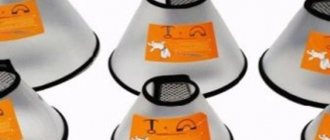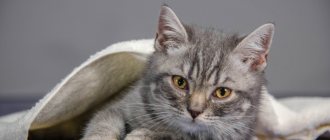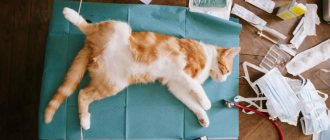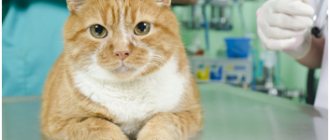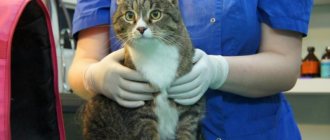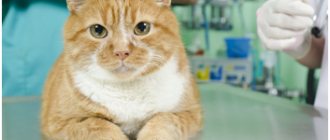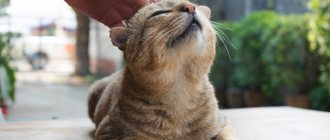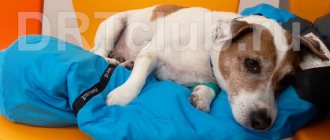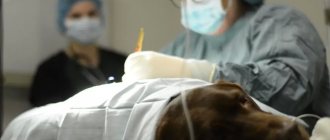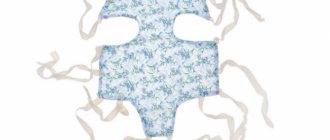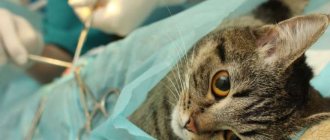Castration of a cat is one of the popular procedures among city residents. Despite its simplicity and accessibility, it still evokes conflicting feelings among owners. Some people consider such an operation necessary to protect their home from unpleasant odors during territory marking, and their pet from unwanted interaction with yard cats. Other owners fear that after castration the cat’s character will deteriorate sharply, and surgical intervention in the reproductive system will cause irreparable harm to the pet’s health. This article will describe the advantages and disadvantages of the operation, and also provide information on how to care for a cat after castration.
Pros and cons of castration
Castration of a cat is a surgical or medical procedure to suppress libido and neutralize the pet’s sexual instincts. Surgery is performed under general anesthesia, during which the testes are removed from within or outside the scrotum. The drug procedure is carried out by inserting a suprelonin implant under the skin on the withers or the skin-fat fold on the abdomen. Castration affects a gradual change in hormonal levels, a decrease in testosterone production and the behavior of the cat in the future.
After castration, the animal requires special care
Pros:
- after sterilization, the cat stops marking the territory of the apartment and screaming for a female;
- aggression towards family members and other pets, caused by the inability to satisfy one’s sexual needs, disappears;
- the absence of sexual instincts reduces the desire to run away from home, preventing the possibility of falling out of the window;
- minimizing close contact with stray females reduces the likelihood of contracting dangerous infections, the pathogens of which provoke viral leukemia, chlamydia, etc.;
- the absence of stress due to the inability to satisfy sexual needs increases the pet’s lifespan by an average of 3-4 years.
Minuses:
- high risk of urolithiasis if the proper diet is not followed;
- a sharp decrease in physical activity with a normal diet leads to the formation of excess weight, increasing the risk of diseases of internal organs and bones;
- the risk of using anesthesia, which increases with each year of a cat’s life. It is recommended to castrate a kitten under 2 years of age. It is recommended that adult pets undergo medical castration.
Reaction to anesthesia
How do cats cope with castration and anesthesia during it? If the animal is diagnosed with heart failure, this may negatively affect the condition after administration of the drug. Also at risk are certain breeds of cats - British, Scottish fold and others.
Signs of complications include severe shortness of breath and heart failure. To prevent this condition, the animal’s heart should be examined before surgery using ultrasound and ECG. If the risk of complications is high, it makes sense to refuse the operation or perform it under local anesthesia.
Caring for a cat after castration in the first hours
How to care for a cat at home
After castration, a cat needs special care. Most veterinary clinics provide post-operative hospital services. In a special box with optimal climatic conditions, the operated pet is observed until it completely recovers from anesthesia. Once convinced that the cat’s condition is satisfactory, it is handed over to its owners.
Care in the first hours after castration comes down to monitoring your pets
If such a service is not available in the clinic or castration is performed at home, it is important to follow the following care recommendations:
- To transport a cat after castration, it is recommended to use a loose carrier with a folding top and an absorbent diaper on the bottom. It is forbidden to transport an operated pet in your arms or in a car seat, as when waking up from anesthesia, it can harm itself or its owner. During transportation and further postoperative stay, the cat is placed on its side;
- It is recommended to lay an anesthetized, operated cat on the floor, since when it comes to its senses, it may fall off the table/sofa/bed. A common symptom of anesthesia sleep is uncontrollable urination. Using an absorbent diaper placed on the floor under the pet will make it much easier to eliminate such a nuisance;
- During anesthetized sleep, body temperature drops by 1-1.5°, so to prevent hypothermia, the operated pet is placed next to a heating radiator. It is strictly forbidden to place animals near electrical appliances with an open heating element. Instead of a battery, you can use a heating pad or a plastic bottle with hot, but not boiling water, which is placed next to the cat under a bedding or blanket. It is important that the heat does not come into contact with the cat's perineum, as this will cause bleeding. During the warm season, no additional warming procedure is required;
- for a more comfortable awakening from anesthesia sleep, it is recommended to close the curtains on the windows, since bright sunlight causes irritation of the optic nerve;
- Anesthesia sleep lasts from 15 to 120 minutes. depending on the method of administration and dose of the drug. During this time, it is necessary to monitor the cat so that it does not bury its nose in anything and suffocate. In addition, cats in this condition do not blink, which can cause the cornea to dry out. It is recommended to drip sterile saline solution, contact lens liquid, or eye drops without antibiotics into the eyes several times;
A protective collar will prevent your pet from licking the wound, further irritating it.
- Often waking up after anesthesia causes aggression in the pet. Therefore, it is recommended to provide the cat with complete rest for 24 hours, limiting access to him by other animals or children. It is forbidden to forcefully wake up your pet. Depending on the individual characteristics, after waking up, the cat may experience an unsteady gait, vomiting, involuntary urination, and a lethargic and drowsy state. This condition can last up to 8 hours, which is normal and should not cause concern;
- the wound on the scrotum after castration is not sutured, so it is recommended to minimize the amount of filler in the tray or replace it with absorbent paper. This will prevent the ingress of small filler particles and subsequent complications;
- A few hours after surgery, there may be slight bleeding from the incision, which is normal and safe for the cat. You can lightly dry the wound with a gauze cloth. In case of significant bleeding of more than 1 ml, you should urgently contact the doctor who performed the operation;
- Medicines prescribed by a veterinarian will help relieve pain. You can tell that a cat needs pain medication by dilated pupils, meowing, pursed paws, and aggression when attempting contact;
- You can prevent the possibility of damage to the healing incision by the cat’s rough tongue during hygiene by wearing a protective collar around the neck for several days. Such a product will limit the cat’s access to the wound without affecting food intake in any way.
Note! Veterinarians recommend castration in the fall or winter months, as during this period the likelihood of infection of the incision during rehabilitation is lower. In the summer, as a preventative measure for infection, the doctor prescribes a 5-day course of antibiotic treatment.
Complications
If the following symptoms are detected while caring for your cat, you should immediately contact a veterinarian:
- Heartbeat disturbance.
- Breathing disorders. The appearance of wheezing during breathing.
- Swelling of the tongue or eyelids.
- Excessive pallor or brightness of the mucous membranes.
One of the important factors is to provide the pet with complete peace, silence, and isolation from other animals during care. Carefully take care of the wound and the toilet, and then he will quickly recover and will delight you with an attractive and healthy appearance.
We recommend reading: What is the best way to feed a neutered cat for its health?
How many hours after castration can you feed a cat?
How long do cats recover from anesthesia after castration: how long can they sleep?
It is not recommended to feed the cat for 24 hours after surgery, since the weakened body will not cope with the digestive process, causing vomiting and its entry into the upper respiratory tract. You can drink a small amount of water no earlier than 4-6 hours after your pet wakes up. It is important to ensure that the sick cat has free access to clean water, since after anesthesia he will be very thirsty.
After anesthesia, your pet will be very thirsty
Toilet
As soon as the cat begins to stand up, it is necessary to place a litter tray with low sides near the bed. It is better to add a filler (silica gel is better, it does not create dust and dirt) that is light in color, so that you can immediately see if there is bleeding or pus.
If this is necessary, then on the first day you can use special diapers for cats.
If the cat avoids the toilet in the first days, this is understandable. Firstly, he had hardly eaten or drunk anything yet. Secondly, he experiences pain and discomfort and delays this moment. As a last resort, you can give your pet a little Vaseline oil.
It’s also okay if the cat goes to the toilet in small portions. This is normal for the first days. Within a month everything should be back to normal. And, most importantly, the urine will no longer have a pungent odor.
Caring for a neutered cat throughout its life
Some time after the operation, the cat’s hormonal levels return to normal. At this time, it is imperative to find a use for the energy that was previously spent on hunting by the female. The simplest solution to this problem is to reduce the calorie intake of the cat and keep him active. Overfeeding and low physical activity lead to obesity in the pet, as a result of which its bones and internal organs suffer.
After surgery, you need to reduce the dose of food and play more often to avoid obesity
Reducing calorie content occurs by replacing familiar foods with lighter and less nutritious ones. The serving size and daily intake should remain the same. For cats whose main diet is industrial food, it is recommended to purchase high-quality dry food from o. They not only have lower calorie content, but also contain special additives that prevent urolithiasis - a common ailment of neutered cats.
Dry food is allowed only premium class
The home diet of castrated animals should consist of lean meat (chicken, beef) and offal (heart, liver, chicken stomachs, lung). It is important to balance natural food with cereals, vegetables (carrots, cabbage, etc.), and fermented milk products. Feeding fish should be avoided due to the increased content of calcium and magnesium, which a neutered pet no longer needs. Excess minerals will accumulate in the kidneys, forming stones.
You should not include fish in your natural diet.
Compliance with the regime, active games and a sufficient amount of attention from household members will help the cat spend the calories received from food.
Note! A neutered cat becomes more sociable, misses its owners more and requires more attention than before. Ignoring this need, the owners begin to encounter dirty tricks and petty vindictive actions with which the cat tries to attract attention. Some owners perceive this as a change in the pet's character for the worse.
How to care for a cat after castration surgery with cryptorchidism
Cryptorchidism is a genetic pathology of cat development, inherited, which is characterized by the presence of one or both testicles under the skin in the groin or abdominal cavity, and not in the scrotum. Such a pathology is a direct indicator for castration, since the testicles are in unnatural conditions, overheating from body temperature. This can lead to the development of pathology of the testes, including the formation of a tumor. Both testicles need to be removed, since sexual behavior is restored when one is removed from the scrotum at the expense of the second in the groin.
Cryptorchidism in a cat
The cost of such castration is much higher, as it requires more actions and additional tools. In addition, it is better to contact a veterinary clinic with such a pathology, where sterility is higher and there is a cryptorchid doctor.
For your information! Some unscrupulous veterinarians, when castrating at home, detect the presence of cryptorchidism already in the process, without additional equipment, they remove only one testicle in the scrotum, leaving the second. The owners do not understand why the cat continues to scream, calling for a female, and marking its territory. When you return to the clinic for consultation, you have to pay for the consultation, x-ray or ultrasound to detect the second testicle, and re-castration.
Typically, surgery to remove the testicles in cats with this diagnosis is carried out in two stages: abdominal surgery to remove the testicle from the abdominal cavity and an incision in the scrotum to remove the second one. A pet operated on in this way requires more careful and complex care. It is important to ensure absolute cleanliness of the suture site. For this purpose, the cat is not allowed to go outside and is brought to the clinic every 3 days to change the bandage.
Bandage after abdominal surgery on a cat
It is recommended to keep the cat in a clean, warm room with a minimum of furniture during recovery. The presence of chairs, tables, and chests of drawers may make him want to jump on them, which can lead to seams coming apart. Daily inspection and treatment of sutures with a veterinarian-recommended product will help avoid redness, the appearance of an unpleasant odor or pus, in which case you need to urgently call a doctor.
The first day after abdominal surgery, the cat’s diet is limited to light chicken broth with a small amount of finely chopped offal. During the entire rehabilitation period, it is recommended to include boiled vegetables in the form of puree using a blender. The fiber contained in vegetables stimulates intestinal motility, which is a good prevention of constipation for pets who have undergone abdominal surgery.
In any case, an operation is an operation, the recovery from which occurs gradually. The owner should monitor the pet, not feed it for the first 24 hours, and treat the stitches to avoid negative consequences.
Treatment of the wound
The groin area should be examined daily and checked for bleeding. Also:
- To help the sutures heal better, they are treated with hydrogen peroxide and brilliant green twice a day.
- You can lubricate the suture area with Levomekol ointment.
- During the rehabilitation period, your cat should be wearing a collar that will prevent the animal from licking the wound. Licking the wound can lead to sutures coming apart and, consequently, infection. During care, it is removed only during feeding.
The rehabilitation period is easier in winter. If the operation was performed in the summer, a five-day course of antibiotic therapy may be required. It is better to play it safe than to treat the resulting infection later.
